Information
Highly-ranked family cemetery from Western Jin Period found in Jianyaomiao, Jiangsu Province
Summary: Jianyaomiao Cemetery from Western Jin period was located in Xinhe Town, Pizhou City, Jiangsu Province. From July 2015 to September 2016, its salvage excavation was carried out by a joint archaeological team consisting of Nanjing Museum, Xuzhou Museum and
Jianyaomiao Cemetery from Western Jin period was located in Xinhe Town, Pizhou City, Jiangsu Province. From July 2015 to September 2016, its salvage excavation was carried out by a joint archaeological team consisting of Nanjing Museum, Xuzhou Museum and so on.

The aerial photo of the Jianyaomiao cemetery
Upper layers of Jianyaomiao Cemetery were cultural deposits from Tang-Song Dynasties to Ming- Qing Dynasties, and lower layers were those from Spring-autumn and Warring States periods. The tombs broke the lower layers. There were 9 tombs being cleared, all of which were south-north oriented with tomb passages in northern part. The tombs had front and back chambers and sloping tomb passages. They were all well-preserved with complete structures. Each tomb has tomb passage, front chamber, side chambers, a single back chamber or more lined side by side.
Funeral goods were found in their original location because of good preservation state of Jianyaomiao Cemetery which had not been looted and disturbed before. More than 300 pieces of burial gifts were uncovered, including various kinds of materials such as gold, silver, copper, iron, conch, shell, glass, carbon, stone, lacquer, porcelain and so on. Based on the forms of their front chambers, the tombs could divide into two kinds, ones with lu-roofs (a roof has 4 pillars, a flat top in square plane and 4 additional pa-beams which make the floor have a square or an octagonal plane) and the others with arched roofs.
1.Tombs having a front chamber with a lu-roof and back chamber(s) with an arched roof (M1, M6,M8)
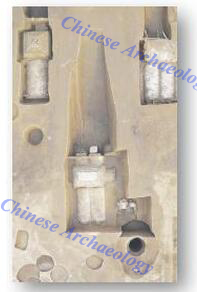
Tomb M1 after excavation
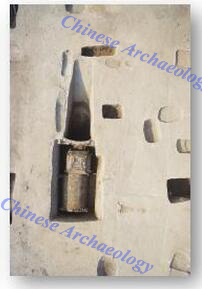
Tomb M8 after excavation
M1 was built by bricks and stones with a sloping passage, two vaulted passages, single side chamber, front chamber with a lu-roof and double arched-roofed back chambers lined side by side. On the lintels of two doors between vaulted passage and the front chamber, there was an incised stone relief describing a traveling scene with horses and carriages. The front chamber had a lu-roof. There drawn with simple black lines and brackets as ornaments on the walls and vertical columns. There was a side chamber with a rectangular plane and an arched roof on the east side of the front chamber. Each back chamber was buried a person. According to the burial gifts, tomb owner of the east back chamber should be a female, while that of the west back chamber should be a male. More than 80 funeral goods were found in the tomb, ranging from glass bowls, shell-made ear cups, nautilus ear cups with copper buckle, ivory cups, golden shallow basins, copper swords, copper and clay figurines, copper basins, copper incense burner, iron mirrors, stone reliefs, coins, pottery ding-cauldrons, pottery basins and so on.
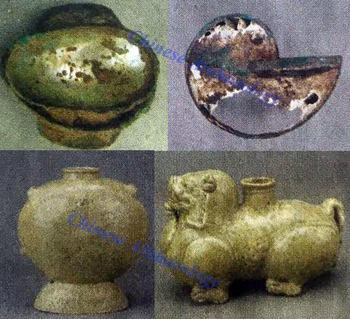
The artifacts such as shell-made ear cups,nautilus cup,celadon flat flask and zoomorphic celadon vessels used to avoid bad luck fopund in the cemetery
Both of tombs M6 and M8 had a single back chamber and a vaulted passage between tomb passage and front chamber. M8 had a long sloping passage, a single vaulted passage, a side chamber, a front chamber with a lu-roof and a brick back chambered with an arched roof. The tomb door was sealed by two layers, both of which were paved with gray bricks. Between tomb door and front chamber, there was a vaulted passage with an arched roof. Front chamber had a lu-roof and side chamber in its east had a corbelled roof. There was only one back chamber and its door deflected to the east side. Inscriptions were found on the middle part of bricked surface of retaining walls. According to the clearance and analysis of burial gifts, this chamber should belong to two persons, where there also should be a female in the east and a male in the west. 26 funeral gifts in various materials were discovered from the tomb, having celadon bowls, celadon jars, celadon bo-bowls, copper hairpins, copper crossbows, copper coins, iron knives, black slabs, bone hairpins, dark reddish brown glazed candle-holders, small jars, gray pottery bowls and so on.
2.Tombs with front and back chambers in arched roofs (M2, M3, M4, M5, M7, M9)
Among them, M2, M5 and M7 all have three back chambers side by side.
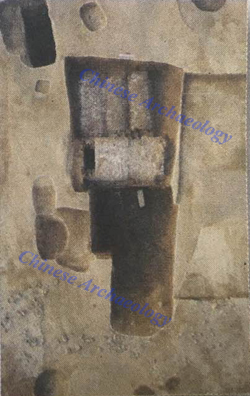
Tomb M2 after excavation
M2 has a sloping passage and 3 back chambers built by bricks and stones. The door was sealed by rectangular gray bricks. The door lintels between the passage and front chamber contained two plain and long stones. The tomb passage was connected to front chamber in the south end. Three chambers are all rectangular with an arched roof and placed in the south side by side. The door lintels of back chambers were built by three blocks of plain and long stones. Two back chambers in the east and middle parts were same in terms of forms and lengths. In additions, back parts of the east and middle chambers were paved by bricks and built as a whole structure from east to west, which should be constructed at the same time. But the roof of the west back chamber was relatively high, which should be constructed later. From the clearance and analysis of funeral goods, we can see that no one was buried in the west back chamber; a male was buried in the middle back chamber and a female was buried in the east back chamber. Besides, more than 30 burial gifts were uncovered from the tomb, ranging from black plates, ewers with a plate-shaped opening, iron mirrors, silver hairpins, copper mirrors, crossbows and so on.
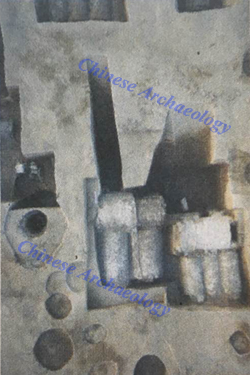
Tomb M3 after excavation and its stratum relation with tomb M2
M3, M4 and M9 are tombs with two back chambers arranged side by side.
M3 had 2 sloping passages and 2 bricked back chambers side by side. The double tomb passages were in the plane of Chinese character “八”. The tomb had secondary rebuilding trace. Back chambers had double-layers arched roofs. According to the burial gifts, tomb owners of back chambers should be a male in the west and a female in the east. In addition, more than 30 pieces of grave goods were uncovered from the tomb, including ewers with chicken-spout, ewers with a plate-shaped opening, copper incense burners, copper basins, gold bracelets, gold rings, iron mirrors, silver hairpins, silver rings and so on.
Academic Values
There are 9 large-scaled tombs being found in Jianyaomiao Cemetery in Xinhe, Pizhou, which being arranged in two lines and southeast-northwest oriented. According to their arrangement, this cemetery is surely predicted to be a family cemetery. Based on the tomb structure and grave goods, the time of the cemetery should belong to Western Jin period. Therefore, it was a very rare family cemetery in archaeological excavations with its complete preservation state for it was kept away from any loot.
There were very clearly observed situations such as multi-times constructions of tomb passages, the extension and added part of tomb chamber. The murals and stone reliefs found from the tombs provide very clear evidences for research on construction of tombs and funeral practice in Western Jin period. They all have significant academic values. Rare burial gifts like nautilus cups, glass bowls and so on imply relatively high social status of tomb owners and also give us information on cultural exchanges and trades between the south and the north, and the west and the east in Western Jin period. Plenty of celadon wares such as flat ewers, zoomorphic vessels used to avoid bad luck, ewers with chicken-spout and so on as well as potteries such as plates, kitchen range and model granaries and etc. uncovered from the excavations suggest communication and integration between the southern and the northern cultures.
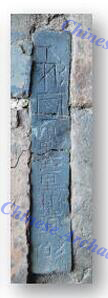
The engraved inscription brick found in tomb M8
The discovery of Jianyaomiao Cemetery from Western Jin is of significant regional values. It’s an important cemetery which adds information to transitional area between Northern China and Southern China. The engraved inscription brick found from M8 suggests that this tomb is related to Xiapi State in Western Jin period and provides significant materials for research on history of Xiapi State in Western Jin. Thus, in a word, the discovery of the cemetery has very important scientific values for systematic research on various social aspects of Western Jin period in terms of its politics, economy, culture, life style, social practices and funeral customs and so on. (Translator: Ma Huanhuan)

The aerial photo of the Jianyaomiao cemetery
Upper layers of Jianyaomiao Cemetery were cultural deposits from Tang-Song Dynasties to Ming- Qing Dynasties, and lower layers were those from Spring-autumn and Warring States periods. The tombs broke the lower layers. There were 9 tombs being cleared, all of which were south-north oriented with tomb passages in northern part. The tombs had front and back chambers and sloping tomb passages. They were all well-preserved with complete structures. Each tomb has tomb passage, front chamber, side chambers, a single back chamber or more lined side by side.
Funeral goods were found in their original location because of good preservation state of Jianyaomiao Cemetery which had not been looted and disturbed before. More than 300 pieces of burial gifts were uncovered, including various kinds of materials such as gold, silver, copper, iron, conch, shell, glass, carbon, stone, lacquer, porcelain and so on. Based on the forms of their front chambers, the tombs could divide into two kinds, ones with lu-roofs (a roof has 4 pillars, a flat top in square plane and 4 additional pa-beams which make the floor have a square or an octagonal plane) and the others with arched roofs.
1.Tombs having a front chamber with a lu-roof and back chamber(s) with an arched roof (M1, M6,M8)

Tomb M1 after excavation

Tomb M8 after excavation

The artifacts such as shell-made ear cups,nautilus cup,celadon flat flask and zoomorphic celadon vessels used to avoid bad luck fopund in the cemetery
Both of tombs M6 and M8 had a single back chamber and a vaulted passage between tomb passage and front chamber. M8 had a long sloping passage, a single vaulted passage, a side chamber, a front chamber with a lu-roof and a brick back chambered with an arched roof. The tomb door was sealed by two layers, both of which were paved with gray bricks. Between tomb door and front chamber, there was a vaulted passage with an arched roof. Front chamber had a lu-roof and side chamber in its east had a corbelled roof. There was only one back chamber and its door deflected to the east side. Inscriptions were found on the middle part of bricked surface of retaining walls. According to the clearance and analysis of burial gifts, this chamber should belong to two persons, where there also should be a female in the east and a male in the west. 26 funeral gifts in various materials were discovered from the tomb, having celadon bowls, celadon jars, celadon bo-bowls, copper hairpins, copper crossbows, copper coins, iron knives, black slabs, bone hairpins, dark reddish brown glazed candle-holders, small jars, gray pottery bowls and so on.
2.Tombs with front and back chambers in arched roofs (M2, M3, M4, M5, M7, M9)
Among them, M2, M5 and M7 all have three back chambers side by side.

Tomb M2 after excavation

Tomb M3 after excavation and its stratum relation with tomb M2
M3, M4 and M9 are tombs with two back chambers arranged side by side.
M3 had 2 sloping passages and 2 bricked back chambers side by side. The double tomb passages were in the plane of Chinese character “八”. The tomb had secondary rebuilding trace. Back chambers had double-layers arched roofs. According to the burial gifts, tomb owners of back chambers should be a male in the west and a female in the east. In addition, more than 30 pieces of grave goods were uncovered from the tomb, including ewers with chicken-spout, ewers with a plate-shaped opening, copper incense burners, copper basins, gold bracelets, gold rings, iron mirrors, silver hairpins, silver rings and so on.
Academic Values
There are 9 large-scaled tombs being found in Jianyaomiao Cemetery in Xinhe, Pizhou, which being arranged in two lines and southeast-northwest oriented. According to their arrangement, this cemetery is surely predicted to be a family cemetery. Based on the tomb structure and grave goods, the time of the cemetery should belong to Western Jin period. Therefore, it was a very rare family cemetery in archaeological excavations with its complete preservation state for it was kept away from any loot.

The engraved inscription brick found in tomb M8
The discovery of Jianyaomiao Cemetery from Western Jin is of significant regional values. It’s an important cemetery which adds information to transitional area between Northern China and Southern China. The engraved inscription brick found from M8 suggests that this tomb is related to Xiapi State in Western Jin period and provides significant materials for research on history of Xiapi State in Western Jin. Thus, in a word, the discovery of the cemetery has very important scientific values for systematic research on various social aspects of Western Jin period in terms of its politics, economy, culture, life style, social practices and funeral customs and so on. (Translator: Ma Huanhuan)
Category: English
News
Information
Key words:
